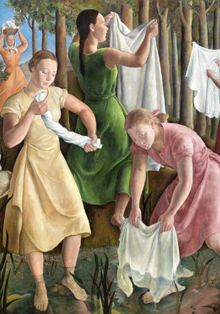Until 15 September, the Museo Nacional Thyssen-Bornemisza is presenting an exhibition devoted to the Spanish figurative painter Rosario de Velasco (Madrid, 1904-Barcelona, 1991), which brings together some thirty paintings from the 1920s to the 1940s – the first and most outstanding years of her artistic career – and a section devoted to her work as an illustrator.
Rosario de Velasco’s work is a magnificent example of the so-called “return to order” in Spain, a movement parallel to the German New Objectivity and the Italian Novecento, with a style that knew how to combine tradition and modernity.
The exhibition, which has the support of the Community of Madrid and Madrid City Council, aims to rediscover and highlight the work of one of the great Spanish artists of the first half of the 20th century. Alongside well-known paintings in museums, such as her famous oil painting Adam and Eve (1932), from the Museo Nacional Centro de Arte Reina Sofía; The Slaughter of the Innocents (circa 1936), from the Museo de Bellas Artes de Valencia; Maragatos (1934), from the Museo del Traje in Madrid, and Carnival (pre-1936), from the Centre Pompidou in Paris, are on display for the first time. Some of the works were previously unaccounted for and have been located and recovered in recent months.
After its presentation in Madrid, the exhibition will be on display at the Museo de Bellas Artes in Valencia from 7 November 2024 to 16 February 2025.







